woelen
Super Administrator
        
Posts: 8014
Registered: 20-8-2005
Location: Netherlands
Member Is Offline
Mood: interested
|
|
Another very old chemical: P2S3?
You probably remember my post on the very old and dirty sodium I had, which I cleaned by melting it.
I also obtained another similarly old chemical. The bottle has no official label, there is a piece of dirty yellow paper on the bottle, on which there
is handwritten: P<sub>2</sub>S<sub>3</sub>. In the bottle there is a yellow/brown compound in the form of a powder, which is
somewhat clumped and slightly humid. The bottle itself is a brown glass bottle, with a bakelite screw cap which has a plate of cork inside and all
around the screw cap there is a thick layer of some fabric, which is soaked with candle wax. I had to irreversibly break the seal of fabric and wax
for opening the bottle. The cork also is covered with a thin layer of some wax-like substance. I think that the bottle is prepared this way several
tens of years ago and that it never has been open afterwards.
If I try to find information about P<sub>2</sub>S<sub>3</sub>, then that is very minimal. The material inside also is somewhat
damp. Would this be on purpose? The solid only has a weak smell, but that smell also could be from the cork or the wax.
What could this compound be? Is it really P<sub>2</sub>S<sub>3</sub> and if so, what can I do with that? I know there also is
a compound with formula P<sub>4</sub>S<sub>3</sub> and this is described as yellow. Could it be that I have
P<sub>4</sub>S<sub>3</sub>? Is there a method to find out what I have?
Yeah, receiving a set of such old chemicals sometimes is challenging, but it also is quite funny (especially if you take into account that I hardly
paid anything for it). It is remarkable that such very old bottles can contain really unusual stuff and I regard this as an example of that.
[Edited on 11-2-10 by woelen]
|
|
|
User
Hazard to Others
  
Posts: 339
Registered: 7-11-2008
Location: Earth
Member Is Offline
Mood: Passionate
|
|
Can you post one of those typical woelen-quality pictures 
What a fine day for chemistry this is.
|
|
|
woelen
Super Administrator
        
Posts: 8014
Registered: 20-8-2005
Location: Netherlands
Member Is Offline
Mood: interested
|
|
I could make a picture of this, but is that interesting? Just a dirty brown bottle with a black cap and some fabric wrapped around the cap.
Actually, the solid is not really yellow/brown, it is somewhat greyish/yellow. The latter is a more accurate description of the color. The material is
very flammable and it burns with an orange flame, giving an incredible amount of white smoke (yes, this is really insane, a pea-sized sphere of the
material makes the entire room filled up with white smoke  ). The smoke is not
particularly offensive when it is breathed, it only is mildly irritating and it smells a little bit like burnt matches (smell of SO2). ). The smoke is not
particularly offensive when it is breathed, it only is mildly irritating and it smells a little bit like burnt matches (smell of SO2).
|
|
|
Polverone
Now celebrating 21 years of madness
        
Posts: 3186
Registered: 19-5-2002
Location: The Sunny Pacific Northwest
Member Is Offline
Mood: Waiting for spring
|
|
I do not know if Google Books blocks you from reading by geolocation, but there is information in there.
For example, Introduction to chemical preparations by Erdmann and Dunlap says:
| Quote: | Phosphorus Trisulphide, P2S3
Mix 310 grams of red phosphorus with 480 grams of pulverized sulphur and add, little by little, by means of a spoon, to a Hessian crucible which is
heated with a Bunsen burner. After the addition of each portion, close the crucible with a cover, whereupon the reaction must immediately take place.
After the whole of the mixture has been added, let the crucible cool to such an extent that the mass is just molten; then pour the sulphide of
phosphorus upon an iron plate. Break into pieces the solidified product, while it is still warm, and put it into a well-stoppered bottle.
Phosphorus trisulphide forms a hard, gray, easily pulverizable mass, which, upon standing in the air, becomes moist and slimy, hydrogen sulphide being
evolved. |
More modern information indicates that P4S6 is a more appropriate formula and that this sort of synthesis does not give rise to a single well-defined
stoichiometric compound. Nevertheless, the old description seems to match what you have fairly well.
PGP Key and corresponding e-mail address
|
|
|
DJF90
International Hazard
    
Posts: 2266
Registered: 15-12-2007
Location: At the bench
Member Is Offline
Mood: No Mood
|
|
P2S3 can also be also be made by reaction of PCl3 with BaS. It might be interesting to see how the product of this reaction matches what you have
there. Also interesting is that Brauer makes no mention of this compound.
|
|
|
woelen
Super Administrator
        
Posts: 8014
Registered: 20-8-2005
Location: Netherlands
Member Is Offline
Mood: interested
|
|
This is amazing stuff!!
Polverone, thanks for the information. I decided to go deeper into the literature, before I do further experiments with this. This is AMAZING stuff
but also dangerous stuff in the hands of the unknowing!
I added some iodine to the solid material. No reaction occurred. Next, I heated somewhat. Iodine evaporates (purple vapor) but still no reaction
occurs. Then I added a single drop of water. When this is done, a gas is evolved, slowly. The gas which escapes smells like H2S and it is flammable.
Iodine, purple vapor is one of the combustion products. The gas mix strongly fumes in contact with air, that fume must be due to presence of HI. So,
the material can be used to make a mix of HI and H2S. Nice but not that exciting, better methods exist for that.
Now comes the better part. I took another small piece of the material and added solid NaOH. Next, I added several drops of water. When this is done, a
lot of colorless gas is produced. When the production of gas became slower, I carefully heated and then production of gas becomes somewhat faster
again. At a certain moment the content of the test tube went POP associated with an orange flame of 10 cm  and dense white smoke was produced. Besides that there was a strong smell of phosphine and dense white smoke was produced. Besides that there was a strong smell of phosphine  I quickly left the room... I quickly left the room...
I repeated the experiment under somewhat more controlled conditions and indeed, the gas I made is pure phosphine. It can be collected under water. I
now have a very easy method of making phosphine at hand and that makes this stuff really amazing  Just add some NaOH and water and you have a source of phosphine gas! A pea-sized lump is good for several test tubes
full of phosphine gas and I expect to do some interesting experiments with phosphine in the near future. Just add some NaOH and water and you have a source of phosphine gas! A pea-sized lump is good for several test tubes
full of phosphine gas and I expect to do some interesting experiments with phosphine in the near future.
For those of you who are concerned about safety, I know the dangers of phosphine, I'll be very careful with that.
[Edited on 11-2-10 by woelen]
|
|
|
woelen
Super Administrator
        
Posts: 8014
Registered: 20-8-2005
Location: Netherlands
Member Is Offline
Mood: interested
|
|
Hmmm, I have been searching the internet and have studied some paper books as well, but I really start doubting that P2S3 (or P4S6) really exists. I
have the book "Chemistry of the Elements" from Greenwood and Earnshaw and this book explicitly tells that no such entity as P4S6 exists. It mentions
the existence of the stable sulfides P4S3, P4S7 and P4S10 and the existence of the more elusive species P4S5 (which easily disproportionates to P4S3
and P4S7) and P4S4.
I have another older book from the 1960's and this book tells that only 4 sulfides of phosphorus are known, being P4S3, P4S5, P4S7 and P4S10. If you
search the Internet then indeed you find some info on P2S3 (or P4S6) but the more scientific data does not mention this compound. Some chinese bulk
sellers mention P2S3 (grey/yellow compound) as what they sell, but I get the feeling that what I have must be some other sulfide of phosphorus.
I am considering analysing this stuff myself, just for the fun of it and for knowing what I have. I have the idea of burning a precisely weighted
amount (e.g. a few tenths of a gram) of this compound and collecting the white smoke and sulphur dioxide from this by dissolving in some water. When
this material burns, a residue remains, and I can weigh that as well. The difference is the burnt material. Weighing the spatula before and after
burning at 0.001 gram precision is not a real problem for me, the main problem is collecting all smoke and gas while at the same time assuring that
the material really burns completely and not partially.
When it burns completely, then all P-content burns to P4O10 and the S-content burns to SO2. My idea is to dissolve all of this and titrate the SO2.
Titrating that is easy (add slight excess of suitable oxidizer, then add KI/starch and titrate back with Na2S2O3 until color just disappears). What
practical setup could I use to do such a burn-test and collect ALL SO2 and assure that no lower oxides of phosphorus are formed? Lower oxides of
phosphorus should be absent, because these also are easily oxidized just like SO2. I just thought of taking a big bottle, ignite the material just
under the open mouth of the bottle and as soon as it burns move it inside the bottle and then keeping the bottle closed. But this is not a really
accurate method, the ignition process and the moving into the bottle never can be done without loosing some smoke and SO2 and it also looks quite
cumbersome to me. If there is someone over here with practical experience in this direction then I would highly appreciate input from such a person.
Another option, which I tried was dissolving the material in conc. HNO3 and then using Ba(NO3)2 for precipitating the BaSO4 formed in this oxidation.
But the material does not dissolve in HNO3, not in conc. HNO3, nor in dilute HNO3, so this method does not work.
[Edited on 15-2-10 by woelen]
|
|
|
bbartlog
International Hazard
    
Posts: 1139
Registered: 27-8-2009
Location: Unmoored in time
Member Is Offline
Mood: No Mood
|
|
Although that sounds like a cool analytical project, would it rule out the possibility that you had some finely mixed sulfides of phosphorous with net
stoichiometry in the area of P2S3? Are P4S3 and P4S5 sufficiently different from the higher sulfides that a mixture would be either readily apparent
as such, or easily separated?
|
|
|
12AX7
Post Harlot
    
Posts: 4803
Registered: 8-3-2005
Location: oscillating
Member Is Offline
Mood: informative
|
|
Well, if you had an induction heater, you could place the material on a metal spoon inside the bottle and heat it remotely. Hmmm...
If you don't mind some risk, the microwave might be able to do a similar job. Downsides are cracking the bottle (from uneven heating) and damaging
the oven (due to light loading). The latter can be helped by putting a glass of water in with the experiment.
Do lower POx reduce SO2? That is, can you ensure the formation of P2O5, thereby making the SO2 more quantitative?
Are there other options, such as titrating against KMnO4 in acid or base?
Can you find anything quantitative about the other reactions you've observed, like the (apparently) PH3 gas?
You could take a sample to an XRD or SEM lab and ask nicely if they'll scan it (maybe bring a sixpack just in case  ). ).
Tim
|
|
|
woelen
Super Administrator
        
Posts: 8014
Registered: 20-8-2005
Location: Netherlands
Member Is Offline
Mood: interested
|
|
@bbartlog: You are right, if I have a mix of e.g. P4S7 and P4S3, which has average stoichiometry of P4S6, then I will not notice the difference, but
if I can do the analysis in a sufficiently accurate way, then at least I do have some more info on the compound I have.
@12AX7: I won't use a microwave oven for this. I have been thinking about how to perform the experiment:
- I take appr. 100 mg of the solid (measured very precisely, using my analytical balance I can weigh at 0.0001 g resolution). I put this on a
combustion spatula and reset its weight (tare to 0).
- 100 mg of solid will require around 110 mg of O2. I'll make some O2, using H2O2/MnO2 and put that in a liter bottle. One liter of pure O2 is around
1.5 grams, so when I have a bottle with e.g. better than 50% oxygen content, then I assure there always is a big excess amount of oxygen in the
bottle. This assures that the phosphorus content always burns to P4O10 and not to lower oxides. The only reducing species then will be SO2. Exact
amount of oxygen is not critical, just assure that large excess is present.
- I put 25 ml of water, with 160 mg KBrO3 dissolved in it in the bottle (before oxygen is added). This certainly will be enough. When the
stoichiometry of my compound is P2S3, then appr. 75% of the KBrO3 will be used up. Even with P4S10 only 90% of the KBrO3 is used up, so I have some
safety margin. I use KBrO3 because that can be weighed accurately (it is not hygroscopic and the material I have is very pure, it is the material I
made by electrolysis of KBr with platinum electrodes and recrystallizing).
- I weigh the combustion spoon together with a granule of P2S3 and put this burning piece in the bottle with screwcap.
- When burning stops, I shake the bottle, until all of the fumes have been absrobed in the liquid. Excess KBrO3 will cause formation of some Br2
vapor, but as this is very dilute most will remain in solution.
- Quickly I open up the cap just a few mm, push in some excess solution of acidified KI and then recap. No loss of Br2 vapor will occur with this,
because after the combustion and dissolving of SO2, there will be underpressure. The amount of KI is not critical, just assure there is an excess
amount.
- I shake again, until all vapor is dissolved and now what remains is KI in solution with I2 from the excess of KBrO3.
- Once all vapor is absorbed, the bottle can be opened and a standard titration can be done.
- The combustion spatula is weighed again, it will have a negative weight due to the tare. The absolute value of this weight is the amount of solid
which really has burnt.
- Afterwards the math can be done.
Only tricky point in this is putting the burning material in the bottle. I am considering making an ignition device with two wires through tiny holes
in a screw cap with a glowing wire on top of the PxSy. This is something which I have to think about. If I do the experiment, then I'll make pictures
of it.
[Edited on 15-2-10 by woelen]
|
|
|
woelen
Super Administrator
        
Posts: 8014
Registered: 20-8-2005
Location: Netherlands
Member Is Offline
Mood: interested
|
|
I have done the experiment as described above, but it only is a preliminary exercise. I could not make a suitable ignition device, the material simple
cannot be ignited in that way with the materials I have at hand. I need to buy some suitable wires for doing this.
So, I did as described above, but with the opening of the bottle to get out the combustion spatula and add solution of KBrO3. This leads to loss of
gas and smoke (white smoke leaves the bottle). I might have lost 10% or even more of the gas in this process and hence the measurement will be low in
S.
I took appr. 80 mg of solid, of which 42.0 mg is burnt (difference before and after burning).
I added 81.5 mg of KBrO3 and then I added large excess amount of KI.
Back titration with a solution of 1.000 gram Na2S2O3.5H2O in 250 ml took 90 ml of solution before all iodine is reduced again, this is 360 mg of
Na2S2O3.5H2O.
Doing the math, this means 184 mg of iodine is neutralized.
184 mg of iodine corresponds to 40.36 mg of KBrO3
40.36 mg of KBrO3 corresponds to 47.42 mg of SO2
I assume formula PS<sub>x</sub>
When 42.0 mg of this burns in oxygen and this yields 47.42 mg of SO2, then you can find that x must be 1.255.
So, empirical formula is PS<sub>1.255</sub>
This is a result which I can live with. This corresponds best with P4S5. But there was loss of SO2 (that loss is the main error in the entire process
and it overwhelms other errors). So, in reality x will be higher. It is not clear how much higher, but if x equals 1.5 then the formula would be P2S3
(or P4S6). Going from 1.255 to 1.5 is a long way, this means that almost 1/6 of the SO2 must have escaped in the process of getting the combustion
spatula out of the bottle and adding solution of KBrO3, but I can imagine that I had such a loss. Also at the start, when the material is ignited,
there is some smoke lost in the air.
I really should try this another time but then I first need to think of a good method of igniting the material in a bottle. I already have one method,
but for that I have to wait a few months. In summertime I can take a magnifying glass and use sunlight to ignite the material inside the bottle, but
now with grey dark and cold winter time this is not an option.
This experiment also learnt me that analytical chemistry is a science on its own. This experiment took me a whole 3 hours to perform. The steps are
soooo sloooow. Especially the dissolving of the SO2 in the solution of KBrO3 takes a long time. The titration with a burette and preparing of the
solutions also takes a long time.
[Edited on 15-2-10 by woelen]
|
|
|
Sauron
International Hazard
    
Posts: 5351
Registered: 22-12-2006
Location: Barad-Dur, Mordor
Member Is Offline
Mood: metastable
|
|
Every modern reference says "P2S3" does not exisrt nor P4S6.
There are P4S3, P4S5, P4S7 and P4S10 ("P2S5")
Mellor described the history of the real and supposed P-S compounds as a comedy of errors.
It seems likely that "P4S6" is a mixture of P4S5 and P4S7 in c.equimolar proportions. See Ullmann, see Brauer, see Mellor (attached)
Attachment: Pages from Mellor ACTOITC 8 N_P.pdf (1.2MB)
This file has been downloaded 871 times
[Edited on 16-2-2010 by Sauron]
Sic gorgeamus a los subjectatus nunc.
|
|
|
woelen
Super Administrator
        
Posts: 8014
Registered: 20-8-2005
Location: Netherlands
Member Is Offline
Mood: interested
|
|
Sauron, I think you are right, it must be a mixture of other sulfides. I niow have read multiple references and only the older literature mentions the
existence of P2S3 or P4S6. For completeness I include a picture of the material. It does not look very attractive, it looks dirty yellow/brown and
slightly wet.
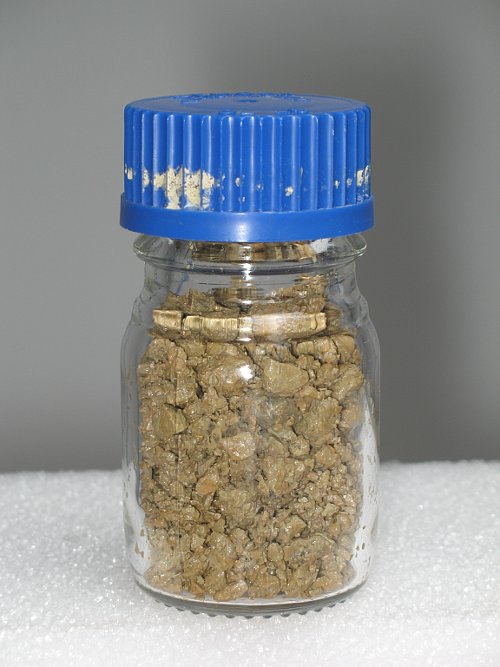
[Edited on 21-2-10 by woelen]
|
|
|
Sauron
International Hazard
    
Posts: 5351
Registered: 22-12-2006
Location: Barad-Dur, Mordor
Member Is Offline
Mood: metastable
|
|
ATBOIC Phosphorus does describe a prep from the elements and cite the primary report bit still as you say the absence from credible references of less
age than 80 years is pretty conclusive.
The commerccial trchnical P2S3 used or formerly used in matches is most likely also not a discrete compound.
The lit suggests that mixtures like this can be resolved by fractionation. An old sample like yous showing signs of moisture will have evolved H2S and
thus changed its original composition somewhat.
Sic gorgeamus a los subjectatus nunc.
|
|
|
The WiZard is In
International Hazard
    
Posts: 1617
Registered: 3-4-2010
Member Is Offline
Mood: No Mood
|
|
Quote: Originally posted by woelen  | You probably remember my post on the very old and dirty sodium I had, which I cleaned by melting it.
I also obtained another similarly old chemical. The bottle has no official label, there is a piece of dirty yellow paper on the bottle, on which there
is handwritten: P<sub>2</sub>S<sub>3</sub>. In the bottle there is a yellow/brown compound in the form of a powder, which is
somewhat clumped and slightly humid. |
I do be stumbling upon this. Greenwood and Earnshaw, Chemistry
of the Elements. 2nd ed. 1997. p.508.
P<sub>4</sub>S<sub>3</sub> is the most stable compound in the series and can be prepared by heating
the required amounts of red P and sulphur above 180<sup>o</sup> in an inert atmosphere
and then purifing the product by distillation at 420<sup>o</sup> or by recrystallization from toluene.
The retention of a P<sub>3</sub> ring in the structure is notable.
Table 12.6 Physical properties of some phosphorus sulfides
alpha-P<sub>4</sub>S<sub>3</sub> — Yellow green
|
|
|
IrC
International Hazard
    
Posts: 2710
Registered: 7-3-2005
Location: Eureka
Member Is Offline
Mood: Discovering
|
|
I believe P2S5 is more likely, a couple examples:
P2S5 + 8H2O = 2H3PO4 + 5H2S
P2S5 + 3PCl5 = 5PSCl3
P2S5 + 3K2S = 2K3PS4
A couple pages from a very old book. Had to squish to 800. Would like to catch the idiot who wrote his name on such a great page in the book.
 
Hard to tell after squishing but is a 5 not a 6.

I should add put it back in a dark bottle.
[Edited on 5-17-2011 by IrC]
"Science is the belief in the ignorance of the experts" Richard Feynman
|
|
|
The WiZard is In
International Hazard
    
Posts: 1617
Registered: 3-4-2010
Member Is Offline
Mood: No Mood
|
|
Quote: Originally posted by IrC  | I believe P2S5 is more likely, a couple examples:
P2S5 + 8H2O = 2H3PO4 + 5H2S
P2S5 + 3PCl5 = 5PSCl3
P2S5 + 3K2S = 2K3PS4
A couple pages from a very old book. Had to squish to 800. Would like to catch the idiot who wrote his name on such a great page in the book.
Hard to tell after squishing but is a 5 not a 6.
I should add put it back in a dark bottle. |
Looks like my 1956 ed of Albert F Gilman, Jr, A Dictionary
of Chemical Equations.
Curious la book does not supply an equation for producing
P<sub>2</sub>S<sub>5</sub>.
It is not in Greenwood & Easrnshaw, Chemistry of the Elements.
2nd ed 1997. However, there dobe P<sub>4</sub>S<sub>10</sub>. A quick check of CS<sub>2</sub> solubility may be
telling.
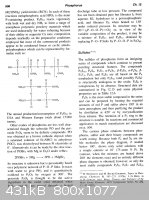 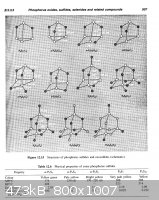 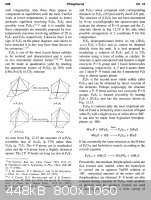 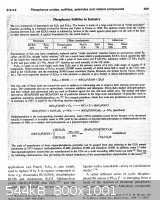 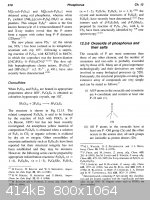
|
|
|
IrC
International Hazard
    
Posts: 2710
Registered: 7-3-2005
Location: Eureka
Member Is Offline
Mood: Discovering
|
|
No, it's my copy of 1956 ed of Albert F Gilman, Jr, A Dictionary
of Chemical Equations. Difference is yours does not have 40 pages spaced throughout where some idiot wrote their name across the page as seen in one
of the pages posted here.
Trade?
"Science is the belief in the ignorance of the experts" Richard Feynman
|
|
|